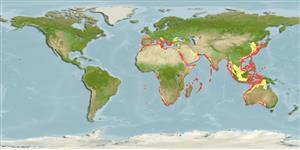Common names from other countries
Environment: milieu / climate zone / depth range / distribution range
Ecología
; rango de profundidad 3 - 600 m (Ref. 804), usually 300 - 400 m (Ref. 804). Subtropical; 48°N - 37°S, 13°W - 139°E
Indo-West Pacific, Eastern Atlantic and the Mediterranean: eastern Atlantic from Gulf of Biscay to Congo and around the Mediterranean, and it is widely distributed throughout the coasts of Morocco.
Length at first maturity / Tamaño / Peso / Age
Maturity: Lm ? range ? - ? cm Max length : 7.8 cm TL macho / no sexado; (Ref. 804)
Minimum depth from Ref. 881. Nektobenthic (demersal) or epibenthic at depths between 75 to 600 m. Infaunal feeder (Ref. 106512). Feeds on euphausiids and mollusks (Ref. 52384).
Life cycle and mating behavior
Madurez | Reproducción | Puesta | Huevos | Fecundidad | Larva
Members of the order Decapoda are mostly gonochoric. Mating behavior: Precopulatory courtship ritual is common (through olfactory and tactile cues); usually indirect sperm transfer.
Bianchi, G., K.E. Carpenter, J.-P. Roux, F.J. Molloy, D. Boyer and H.J. Boyer. 1999. (Ref. 804)
IUCN Red List Status (Ref. 130435)
CITES status (Ref. 108899)
Not Evaluated
Not Evaluated
Human uses
| FishSource |
Herramientas
Fuentes de Internet
Estimates based on models
Preferred temperature
(Ref.
115969): 8.6 - 15.9, mean 11.6 (based on 245 cells).
Resiliencia
Alto, población duplicada en un tiempo mínimo inferior a 15 meses (K=0.4-0.48).
Vulnerability
Low vulnerability (10 of 100).
